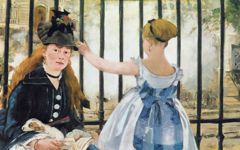Manet’s Boy with a Sword (1861)
Manet's painting of his son dressed in the Dutch manner holding a giant sword has never made much sense. As almost always, though, Manet's sources - the paintings he "copied" from - are significant and help explain his meaning. It has occasionally been noted that Manet might have adopted the boy's pose from an Italian painting not a Dutch one: Caravaggio's Alof de Wignacourt and his Page in the Louvre.1
Click next thumbnail to continue

L: Caravaggio, Portrait of Alof de Wignacourt and His Page (1607-8) Oil on canvas. Louvre, Paris
R: Engraving after Caravaggio's Alof de Wignacourt and His Page
Click image to enlarge.
Although Manet knew the original, he probably used an engraving because the pose is inverted. But why did he use a boy who is not the principal sitter? Wignacourt was the Grand Master of the Knights of Malta and his page would aim for a similar title. Thus the young Manet, who aimed to become a French Grand Master himself, wittily used the protegé of a French "Grand Master" as his source.
Click next thumbnail to continue
As regular users know, a sword in art is often on the poetic level a paintbrush. (See the many examples described here.) Manet even used a sword as a paintbrush in his celebrated picture of Mlle. V in the Costume of an Espada the next year. [See its own entry.]
Click next thumbnail to continue

Top: Titian, Venus and Adonis (c. 1553) Oil on canvas. Prado, Madrid
Bottom: Manet, Justice after Andrea del Sarto (c.1857)
Click image to enlarge.
As a student Manet had copied a figure by Andrea del Sarto of a woman holding a giant sword (bottom). He was presumably attracted not by its originality but by its meaning. He might also have seen other works in which the symbol for the paintbrush is greatly enlarged as in Titian's use of an arrow in Venus and Adonis (top). Swords are full of symbolism. In alchemical literature they bring about the solutio or separation of the elements; they represent ideas penetrating consciousness; they both vivify and kill. The sword is, Jung wrote, the force which turns something infintessimally small into something infinitely great.
Click next thumbnail to continue

L: Manet, Boy with a Sword
R: Photographs of Fresh Direct Product Managers holding the tools or product of their profession. The images are copyright of Fresh Direct Inc.
Click image to enlarge.
Thus Boy with a Sword, painted at the very beginning of Manet's career, is his oath to painting. He declares his loyalty to Art through an image of his son holding a giant "paintbrush". The use of his son who represents Manet "born-again" and ready to confront the future clearly indicates Manet's vast ambition.
Interestingly, an online grocery in the New York area promotes its managers holding the tools and products of their profession in giant form (near left). They too concisely express their employee's devotion to his or her trade. Manet, essentially, did the same.
More Works by Manet
See how smoke and mirrors turn the outside of Manet's studio into the inside

Manet’s The Railway (1873)
Notes:
1. A number of explanations for Boy with A Sword have been offered. Reff noted that because the boy ‘looks’ at the artist the sword is a symbol of Manet as a 17th century courtier in the guise of Velazquez, a fairly accurate interpretation (Reff, 1962, pp. 185). Moffett suggested that it may refer to Manet’s accomplishments as a swordsman which is quite wrong as Manet’s personal interests and concerns do not appear in his work (New York, 1983, p.76). A more recent but far-fetched interpretation is that the sword is an emblem of Manet’s sexual and amorous transgressions (Brombert, 1994, p.496). Swords also appear in the Second Frontispiece etching, La Peche, Mlle V. in the Costume of an Espada, Luncheon in the Studio, Faure as Hamlet, The Tragic Actor and The Dead Toreador.
Original Publication Date on EPPH: 04 Mar 2012. | Updated: 0. © Simon Abrahams. Articles on this site are the copyright of Simon Abrahams. To use copyrighted material in print or other media for purposes beyond 'fair use', you must obtain permission from the copyright owner. Websites may link to this page without permission (please do) but may not reproduce the material on their own site without crediting Simon Abrahams and EPPH.




